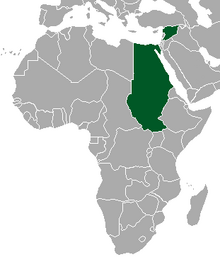| |||||||
| Anthem | "Walla Zaman Ya Selahy" | ||||||
| Capital (and largest city) |
Cairo | ||||||
| Language | Arabic | ||||||
| Religion | Islam; Christianity; Druze | ||||||
| Demonym | Ittihadi; Ittihadi Arabian; UAR | ||||||
| Government | Constitutional presidential republic; Federal state | ||||||
| Legislature | National Assembly of the United Arab Republic | ||||||
| President | |||||||
| Prime Minister | |||||||
| Population | 163,984,022 | ||||||
| Established | February 22, 1958 | ||||||
| Currency | Ittihadi pound (ABP)
| ||||||
| Time Zone | EET (UTC+2) | ||||||
| Calling Code | +20 | ||||||
| Internet TLD | .ab متحدة. | ||||||
| Organizations | Commonwealth Confederation | ||||||
The United Arab Republic (Arabic: الجمهورية العربية المتحدة al-Ǧumhūriyyat al-'Arabīyah al-Muttaḥidah, UAR) is a transcontinental country spanning from the northeastern corner of Africa to the western corner of Asia. Most of its territory of 2,896,068 sq km lies within North Africa and is bordered by the Mediterranean Sea to the north, Palestine and Israel to the northeast, the Red Sea to the east, Libya to the west, South Sudan to the south, Eritrea and Ethiopia to the southeast, and the Central African Republic to the southwest. The UAR is a member of the Commonwealth Confederation
The UAR is one of the most populous countries in Africa and the Middle East, and the 8th most populated in the world. The great majority of its over 117 million people live near the banks of the Nile River, an area of about 100,000 sq km , where the only arable land is found. The large regions of the Sahara Desert, which constitute most of the UAR's territory, are sparsely inhabited. About half of the Ittihadi citizens live in urban areas, with most spread across the densely populated centers of greater Cairo, Damascus, and Alexandria.
History
On July 22, 1952, a group of Egyptian military officers called the Free Officers Movement toppled King Farouk. Led by Muhammad Naguib and Gamal Abdel Nasser, the Free Officers turned Egypt into a republic on June 18, 1953; Naguib became its first president. Sudan, which had legally united into the Kingdom of Egypt and Sudan in 1951, was granted self-government in March 1953 by the Egyptians and British. Immediately, all political parties were dissolved and banned, including the Muslim Brotherhood which opposed secular tendencies of the new republic.
The crackdown of other political parties and the creation of single-party system under the Liberation Rally led by Prime Minister Gamal Abdel Nasser led to the disputes between him and Naguib. On October 26, 1954, an assassination attempt suspected by the Brotherhood was directed at Nasser during a rally in Alexandria. Nasser not only survived, but proceeded to continue his speech to the panicked audiences, which broadcasted to the Arab World by radio. The crowd roared in approval and Arab audiences were electrified, making him more popular figure among the Arabs across the Middle East.
This led to the regime acting against the Brotherhood, executing Brotherhood leaders on 9 December. Nasser then forced Naguib to resign on November 14, 1954 for the latter's leniency toward the Brotherhood; Naguib was put into house arrest. The assassination attempt also put Nasser at confrontation with King Abd al-Ilah of Hejaz whom he suspected had secretly funded the Brotherhood. Nasser became the president of Egypt following Naguib's resignation.
He then pushed for rapid implementation of land reform. Prior to 1952, less than six percent of Egypt's population owned more than 65% of the land in Egypt, while at the top and less than 0.5% of Egyptians owned more than one-third of all fertile land. During the presidency of Nasser, cultivated land in Egypt increased by almost a third. Nasser's socialist policies also expanded the public sectors of Egypt, further transferring the country's wealth previously accumulated by the rich elite to the state and small-sized businesses.
Arab nationalist terms such "Arab homeland" and "Arab nation" frequently began appearing in his speeches in 1954–55, whereas prior he would refer to the Arab "peoples" or the "Arab region". When the United States held up military sales in reaction to Egyptian neutrality regarding the Soviet Union, Nasser turned toward the Eastern Bloc and concluded an arms deal with Czechoslovakia in September 1955. His independent foreign policies and socialist domestic policies were culminated to the American-British withdrawal from funding Nasser's infrastructure projects.
To fund his public work projects, Nasser decided to nationalize the Suez Canal on July 26, 1956. The nationalization escalated tension with the United Kingdom and France, which froze Egyptian assets and put their armies on alert. Israel, which its cargo shipments has been subjected to the Egyptian control since 1948, also felt a need to reopen the Straits of Tiran leading to the Gulf of Aqaba to Israeli shipping as well as to strengthen its southern border from an increasingly hostile Egypt. The crisis resulted in the invasion of Egypt on October 29, 1956 by the United Kingdom, France, and Israel.



